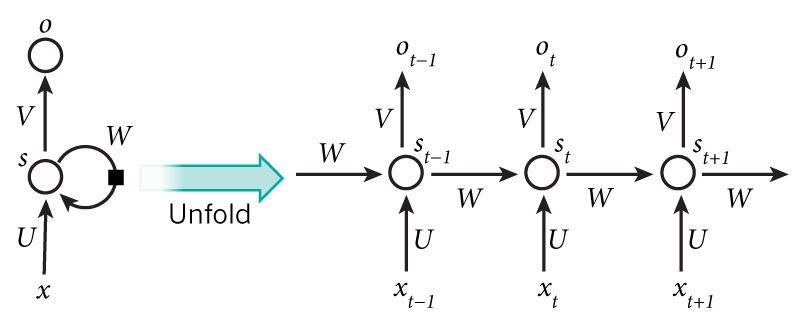Recurrent Neural Networks Tutorial, Part 1 – Introduction to RNNs
What is RNN?
RNN的核心思想是利用时序信息。在传统的神经网络中,我们通常假设所有的输入(输出)相互之间都是独立的。但是在很多实际的应用中这是一个非常不好的假设。比如我们要预测一个句子中的下一个单词,我们最好能知道上一个单词是什么。
RNN中的R代表Recurrent,意味着它对每一个单元进行顺序的重复操作,每一次输出都和前面的运算结果相关。另一个理解RNN的方法就是构造“记忆”的概念,RNN拥有的“记忆”可以获取之前计算的信息。理论上,RNN可以利用任意长结果的时序信息,但是在实际应用中,RNN受限于只能获取之前几个块的信息。

is the input at time step t. For example, could be a one-hot vector corresponding to the second word of a sentence.
is the hidden state at time step t. It’s the “memory” of the network. is calculated based on the previous hidden state and the input at the current step: . The function f usually is a nonlinearity such as tanh or ReLU. , which is required to calculate the first hidden state, is typically initialized to all zeroes.
is the output at step t. For example, if we wanted to predict the next word in a sentence it would be a vector of probabilities across our vocabulary. .
我们可以将隐藏状态 看作是网络的记忆。 捕捉在前几次网络运算中所包含的信息。每个时刻的输出 只和该时刻的记忆有关。
和传统的神经网络不同, RNN每一层都共享同样的参数(如前文中的U,V,W)。这表明我们是在重复地执行同样的步骤,只是每个时刻的输入有所不同。这极大地减少了我们运算所需要存储的权值。
上述过程的每个时刻都有一个输出,但根据不同的应用场景,这个输出不是必要的。